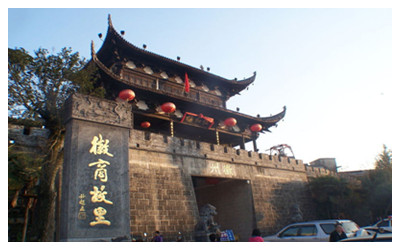Skype: neodalle-travel
Tel: +86 135 7447 2266
E-mail: sales@zhangjiajieholiday.com

 The success of Huizhou merchants had no doubt played a decisive part in the emergence and growth of Huizhou culture. Huizhou merchants generally refer to businessmen from the six counties under Huizhou Prefecture---She County, Xiuning, Qimen, Yixian, Jixi and Wuyuan. Most researchers believe that Huizhou merchants as a whole came into being in the southern Song Dynasty (1127~1279), began to develop between the late Yuan (1271~1368) and the early Ming dynasty (1368~1644), formed a power around mid-Ming period, flourished during Jiajing's reign (1522~1567), reached their culmination during Qianlong's reign (1736~1796), and then declined during Jiajing's and Daoguang's reigns (1796~1851).
The success of Huizhou merchants had no doubt played a decisive part in the emergence and growth of Huizhou culture. Huizhou merchants generally refer to businessmen from the six counties under Huizhou Prefecture---She County, Xiuning, Qimen, Yixian, Jixi and Wuyuan. Most researchers believe that Huizhou merchants as a whole came into being in the southern Song Dynasty (1127~1279), began to develop between the late Yuan (1271~1368) and the early Ming dynasty (1368~1644), formed a power around mid-Ming period, flourished during Jiajing's reign (1522~1567), reached their culmination during Qianlong's reign (1736~1796), and then declined during Jiajing's and Daoguang's reigns (1796~1851).
The history of Huizhou merchants covers about 600 years, and for 300 years they dominated the region. They occupy a significant place in the history of Chinese commerce. In the Southern Song Dynasty, as the capital was moved from Kaifeng to Lin'an (now Hangahou), the political and economic centre shifted to the south. This stimulated the economy of neighboring areas to develop, and then the Central Plains culture was introduced to the South. Huizhou was situated in an important place between Dingus and Zhejiang Provinces. It was significant to the economy of southeastern China as a communication hub between the south and the North. As a result of Huizhou's particular geographical condition and the need of economic development, landowners began to take up business.
At the beginning of the Southern Song Dynasty, according to records, Huizhou people were "engaged in trade every where", selling tea, ink, paper and wood. After Jiajing's reign in the Ming Dynasty, the number of traders amounted to 70% of the total Huizhou population. As the saying goes, "It is a Huizhou practice that thirteen year-olds start their career in town and at seventeen they do business all over the country". Usually at the age of 12 or 13, Huizhou children began to work as apprentices in town. The shortage of land and the superfluity of manpower drove the farmers away from farming. The Ming Dynasty Anhui Chronicle comments, "Many Huizhou people take up business, because they have no other choice". Generally they did small trading, and most of them were under the control of big business. They were not born merchants. Their success was a result of various social factors and their painstaking efforts. The Huizhou Chronicle of the Jiaqing years (1796~1821) describes them as "properly dressed, well-spoken", "fully aware of prices, knowing when to buy and sell, and gaining extra profits from selling local goods at other places". The earliest people who left Huizhou to "make a living away from home" never suspected that a flourishing Huizhou business would "spread almost all over the country", and that Huizhou merchants would "gain a national fame".
Huizhou business was almost all-embracing --- tea, grain, salt, silk, cloth, wood, paint, paper, ink, pottery, etc. simply anything profitable. They opened teahouses, restaurants, hotels and pawnshops. The salt trade and pawn-broking, however, were the most prosperous. It is recorded in She County Chronicle --- Local Conditions that "of all the trades in She County, salt, pawn-broking, tea and wood are most prosperous, though salt prevailed in the past". The pawn-broking in those days was actually usury. Wei Chaofeng, a huizhou pawnbroker depicted in Fantastic Stories, deprived a scholar of his real estate in three years' time by changing exorbitant rates of interest. By the years of Guangxu's reign (1875~1909), one could hardly find a pawnbroker who was not from Huizhou, there was "no place too far for Huizhou merchants to expand". They pressed eastward to the north of Jiangsu, westward to Yunnan, Guizhou, and Gansu, northward to the east and south of Liaoning, and southward to Fujian and Guangdong, and further fouth they sailed to Japan, Thailand and other Southeast Asian countries, their footmarks left on "almost half of the globe".
The resourceful Huizhou merchants were well versed in the expertise of obtaining a position so as to attach themselves to the court. Their strategy was to "provide funds for academic pursuits with business profits, and get political positions through academic pursuits and ensure business profits from the political positions". Therefore, politics and commerce were closely related in Huizhou merchants, having gained fame and fortune, they returned home in all their glory and went on with large-scale construction, building mansions, ancestral temples, guild-halls, roads and bridges to honor their ancestors and to extend the influence of the clan. They were bent on establishing academies, schools, and examination centres and cultivating feudal intellectuals to consolidate the patriarchal clan system. In the Ming and Qing Dynasties (960~1911), 2,108 people from five counties (She County, Yixian, Qimen. Jixi) were granted the title of jinshi (top scholar) after they passed final imperial examinations held every three years and presided over by the emperor.
During the Ming and Qing Dynasties (1368~1911), the literary works of 343 people from Shexian County alone were included in Best Poems or Best Essays. There are stories about "three successive Jinshis from one place, four Hanlina (members of the Imperial Academy) within ten li", "father and son both ministers", "brothers both prime ministers" and "three generations of imperially-honored courtiers", With academic studies and etiquette greatly advocated, Huizhou was a cradle for talented scholars who made achievements in various domains. Huizhou culture, enriched with these achievements, displays a splendid view of liberal arts and history.
 Ask Questions ?
Ask Questions ?